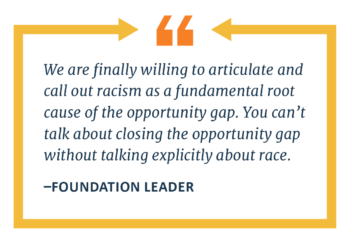Calls for changes in foundation practice have come for decades from philanthropic and nonprofit leaders and others in the sector. The ways in which foundations responded to these calls at the onset of the COVID-19 pandemic in early 2020 have been well-documented and widely discussed, including in a series of three reports released late last year by the Center for Effective Philanthropy (CEP). However, whether foundation leaders would continue these changes beyond 2020 was an open question.
 To better understand current foundation practice, CEP gathered data from 284 foundations leaders who responded to a survey and conducted in-depth interviews with 33 foundations and 32 nonprofit organizations who are part of CEP’s Grantee Voice Panel. (All data was collected in April through June 2021.)
To better understand current foundation practice, CEP gathered data from 284 foundations leaders who responded to a survey and conducted in-depth interviews with 33 foundations and 32 nonprofit organizations who are part of CEP’s Grantee Voice Panel. (All data was collected in April through June 2021.)
It is clear from the data released in our new report, Foundations Respond to Crisis: Lasting Change?, that foundations have indeed continued to change many practices and that they plan to continue most of these changes in a post-pandemic future.
Among these changes are a reduction in administrative burdens for grantees, including grant application and reporting requirements, increased unrestricted funding, and new efforts to advance racial equity.
This is not to suggest, obviously, that challenges do not remain. The data reveals continued shifts in practice but it also reveals disconnects, barriers, and additional opportunities for further change — and foundation leaders themselves are quick to acknowledge they still have a lot of work to do. Ultimately, only time will tell whether these changes become permanent elements of foundation practice.
 The Ford Foundation provided funding to support this research, along with Charles and Lynn Schusterman Family Philanthropies, The David and Lucile Packard Foundation, Raikes Foundation, Weingart Foundation, and William and Flora Hewlett Foundation.
The Ford Foundation provided funding to support this research, along with Charles and Lynn Schusterman Family Philanthropies, The David and Lucile Packard Foundation, Raikes Foundation, Weingart Foundation, and William and Flora Hewlett Foundation.
This report is co-authored by Ellie Buteau, Ph.D., Naomi Orensten, and Satia Marotta, Ph.D.
Data collection instruments used to gather information for this report are available here.
November 2021



